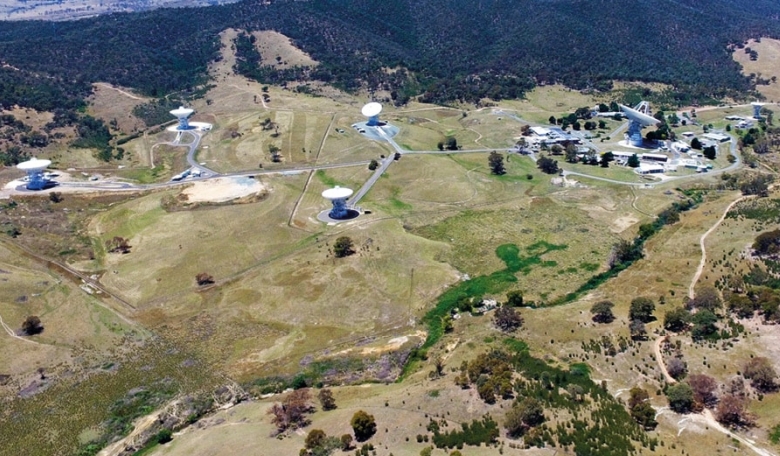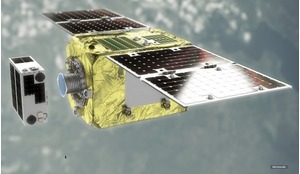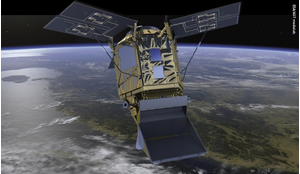Port Adelaide
Right on the doorstep of the International Astronautical Congress, the South Australian Aviation Museum (SAAM) at Port Adelaide offers a small display of British and Australian sounding rockets launched at Woomera, together with a good collection of civil and military aircraft, many with specific South Australian connections, and aviation memorabilia. Easily reached by public transport, the SAAM is part of a heritage precinct that also includes the National Railway Museum and the South Australian Maritime Museum. www.saam.org.au/
Woomera, South Australia
Established in 1947 to test British long-range missiles and other weapons, Woomera Rocket Range was also the hub of space activities in Australia from the 1950s to 1980. Several significant programmes were carried out there, commencing with the British Skylark and Australian sounding rocket programmes in 1957.
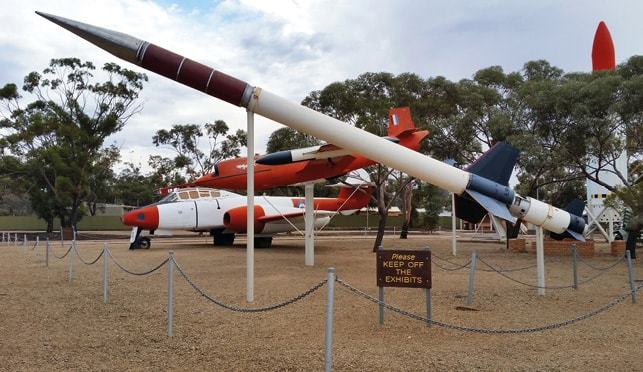 Part of the Woomera rocket park, showing a Skylark rocket and the Black Arrow reconstruction in the background.
Part of the Woomera rocket park, showing a Skylark rocket and the Black Arrow reconstruction in the background.
Britain’s Black Knight research missile was used 1958 - 1965 for a range of defence research projects focussed on upper atmosphere studies: additional research was carried out under Project SPARTA in 1966 - 67 using American Redstone rockets. From 1964 - 1970, ELDO, the European Launcher Development Organisation (a precursor of the European Space Agency) conducted its Europa launch vehicle programme, the largest space project undertaken at Woomera.
Although ELDO never managed to launch a satellite during this programme, Australia’s first satellite WRESAT (celebrating its 50th anniversary this year) was launched from Woomera in 1967, and the last launch of Britain’s Black Arrow programme, active 1969 - 1971, lofted Prospero, the second satellite to achieve orbit from Woomera.
Woomera was also the home of space tracking facilities initially established in conjunction with the International Geophysical Year (IGY). Transferred to NASA on its creation, these facilities were moved in the early 1960s to Island Lagoon, about 25 km south of Woomera, where NASA established an early deep space tracking station in 1960.
This station played an important role in the early exploration of the Moon, Mars and Venus, as well as the Apollo programme, before being closed in 1972. A spaceflight tracking station used for the Mercury, Gemini programmes and early Apollo Saturn rocket tests was also established on the Range, operating from 1960-66.
Located not far from Island Lagoon, the Joint Defence Facility Nurrungar was operated by the United States Air Force and the Australian Department of Defence from 1969 to 1999. Its role was space-based surveillance, especially the early detection of missile launches and nuclear tests using US Defence Support Program geostationary satellites.
Today, the Woomera Range Complex (as it is now known) is a busy weapons test facility with little direct involvement in space activities, although a refurbished sounding rocket launch facility is maintained and available for research use.
The Range has been designated as a National Engineering Landmark by Engineers Australia and as a Historic Aerospace Site by the American Institute of Aeronautics and Astronautics, but access to the former space facilities is extremely restricted, as is the abandoned Nurrungar complex, although its remaining radome can be seen from the highway shortly before the turnoff to Woomera itself.
The Island Lagoon tracking station site (of which, sadly, little remains apart from a few concrete footings) is also no longer accessible without prior permission from the manager of Arcoona station (ranch) on which it is situated.
However, the Woomera Village, originally built to house the staff working on the rocket range, is open to tourists and is well worth a visit for the serious space history buff. The Woomera Heritage Centre, in the heart of the village, provides an excellent exhibition that presents the history of the range from its establishment in the aftermath of World War 2 until the early 2000s.
Its collection of historic artefacts is complemented by the nearby rocket park and Woomera History Museum. The Woomera Rocket Park has a large outdoor display of original (or reconstructed-from-available-parts) missiles, weapons, rockets and aircraft used or tested at Woomera.
While Australia is not considered a significant spacefaring nation, it has a long history of space activities stretching back to the beginnings of the Space Age
Space-related highlights include Black Arrow and Black Knight rockets, a Skylark sounding rocket, a variety of Australian sounding rockets and a Jabiru hypersonic research rocket. Of particular interest are the remains of the Redstone rocket used to launch the WRESAT satellite and those of the ELDO Europa F-4 vehicle. Recovered from their original desert impact locations by heritage-minded Woomera personnel in 1989 and 1994, these rocket relics are laid out on beds of desert sand inside protective cages. A recovered Rolls Royce RZ2 engine from the F-4 vehicle is also on display.
Housed in what was originally St Barbara’s Anglican Church, the Woomera History Museum serves as the repository of heritage material - artefacts, photos, archives, memorabilia and other items - that could not be accommodated in the main Heritage Centre display. While the presentation is rather haphazard, if you have a strong interest in the history of Woomera you will find hours of fascination browsing through the photographic collections and the bound copies of the Gibber Gabber, the Woomera newspaper.
Located in the ‘Outback’ about 480 km from Adelaide, Woomera is about a six-hour drive on good sealed roads, with a car being the only convenient way to get there (although it is also possible to fly into the town of Roxby Downs, and hire a car to drive the 100 km to Woomera).
Be prepared to see kangaroos, emus and other native wildlife as you travel north from Port Augusta. Accommodation at Woomera is limited to the Woomera Travellers’ Village and Caravan Park (http://www.woomera. com/p/accommodation-at-woomera.html) and the ELDO Hotel.
As its name suggests, the ELDO was originally the hostel and recreation facility established for personnel working on the ELDO project. Guests stay in refurbished and modernised accommodation blocks bearing the names of major rocket and missile programmes conducted at Woomera.
Further information and accommodation bookings are available via: www.facebook.com/eldohotel. As it will be school holiday time when the congress takes place, advance bookings are recommended at Woomera, as it is a popular stopover for people travelling to and from the Northern Territory.
Sydney, New South Wales
Visitors to Sydney should not miss the Space exhibition at the Powerhouse Museum, situated in the heart of the city at Darling Harbour. Australia’s largest space history and technology exhibition, it places Australian space activities in their global context. Its exhibits include an Apollo 16 Moon rock and the unique Zero G Space Lab, an interactive exhibit that uses special effects to trick the mind and create the illusion of being in a microgravity environment.
The Powerhouse is also home to the Mars Lab, an innovative education programme that brings together high school education and university research around the development of robotic roving vehicles and the search for life on Mars. As part of this, students from across Australia and around the world can remotely operate research-grade robot rovers in the Mars Yard, a large, high fidelity recreation of the Martian surface.
Some Australian artefacts from the museum’s space technology collection can also be seen at the Museums Discovery Centre, a display storage facility used by Sydney’s major museums and situated at Castle Hill in western Sydney.
Also worth visiting for those with an interest in the history of Australian astronomy is the Sydney Observatory, the oldest surviving observatory in the country. Located right beside the Sydney Harbour Bridge, the observatory presents exhibitions about the history of astronomy in Australia and is also open for night time stargazing, using both its heritage 29 cm refractor telescope (the oldest working telescope in Australia) and a state-of-the-art 40 cm reflector.
The Powerhouse, the Museums Discovery Centre and Sydney Observatory, are all part of the Museum of Applied Arts and Sciences and further information about each venue can be found at https://maas.museum/
Parkes, New South Wales
Woomera Rocket Range was also the hub of space activities in Australia from the 1950s to 1980
One of the world’s great radio astronomy instruments, the Parkes Radio Telescope has also played a significant role in space exploration. In addition to being the technological prototype for the 64 m dishes of NASA’s Deep Space Network, Parkes has played a vital role in various NASA and ESA deep space missions and also in the Apollo lunar programme.
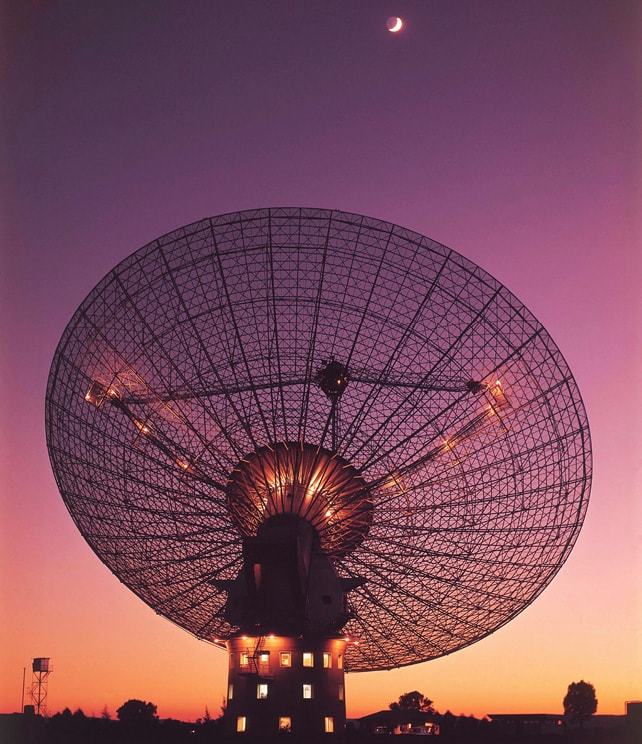 A view of the Parkes Radio Telescope in 1969, during its involvement with the the Apollo 11 mission.
A view of the Parkes Radio Telescope in 1969, during its involvement with the the Apollo 11 mission.
Australian film The Dish was based upon its role in bringing the Apollo 11 moonwalk broadcast to the world, and Parkes also played a critical role in the rescue of the Apollo 13 crew. While the radio telescope itself is not generally accessible to the public, except on special open days (check the website closer to time to see if one will be occurring during any planned visit), it operates an excellent visitors’ centre with displays on astronomy and space science, a 3D theatre and an award-wining café.
Some 370 km west of Sydney, Parkes is best visited by road (about a six-hour drive from Sydney), although air/bus and train/bus travel options are possible. The lovely regional centre of Parkes, and its nearby heritage town of Forbes, are recommended as locations to spend a few extra days sightseeing.
Information on the Parkes facility’s opening hours and how to get there can be found at: www.csiro.au/en/Research/Facilities/ATNF/Parkes-radio-telescope/Parkes-Observatory-Visitors-Centre/Hours-location
Canberra, Australian Capital Territory
Australia’s national capital region was the home of NASA’s second generation of tracking stations in Australia, with three stations established south of the city - Tidbinbilla (for the Deep Space Network), Orroral Valley (for the Satellite Tracking and Data Acquisition Network station) and Honeysuckle Creek (for the Manned Space Flight Network).
Tidbinbilla and Honeysuckle Creek jointly participated in the Apollo programme, playing particularly critical roles in the Apollo 11 and 13 missions. Honeysuckle Creek actually brought the world the television images of Neil Armstrong stepping onto the lunar surface, before the rest of the Apollo 11 television broadcast was relayed via Parkes.
![]() The historic dish from Honeysuckle Creek tracking station that received the television signals of Armstrong’s first steps on the Moon, now a heritage monument at CDSCC.
The historic dish from Honeysuckle Creek tracking station that received the television signals of Armstrong’s first steps on the Moon, now a heritage monument at CDSCC.
Today, as the Canberra Deep Space Communication Complex, only the Tidbinbilla station remains in operation, playing a crucial role in planetary exploration. While the tracking station itself is not open to the public, the facility has an excellent Visitors’ Centre, with displays covering the history of the station in the wider context of planetary exploration.
Australia’s national capital region was the home of NASA’s second generation of tracking stations
The section on the Apollo missions includes the largest lunar sample on public display in Australia. The original antenna from the Honeysuckle Creek tracking station, which received the historic Apollo 11 broadcast, was transported to Tidbinbilla after the station closed in the early 1980s and can be seen near the tracking station entrance. Finally retired from operations in 2009, it was declared a Historic Aerospace Site in 2010 by the American Institute of Aeronautics and Astronautics.
Located 35 km southwest of Canberra, the Canberra Deep Space Communication Complex is only accessible by car, a 45-minute drive through scenic forest, farmland and a nature reserve. Have lunch at the Moon Rock Café and make a day of your visit by venturing on from Tidbinbilla to the sites of the former Honeysuckle Creek and Orroral Valley stations (now both included on the Heritage Register of the Australian Capital Territory). Although little remains at these sites now but concrete footings, both have some interpretive signage outlining their NASA histories. For information on visiting Tidbinbilla go to:www.cdscc.nasa.gov
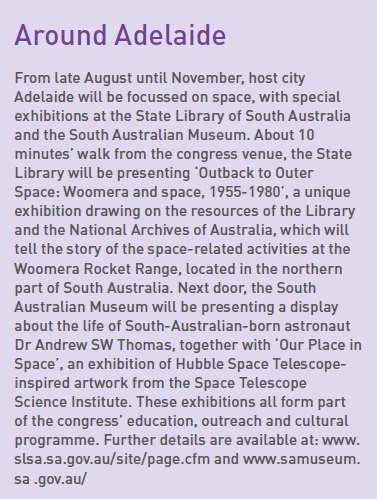
For the adventurous with plenty of time, a road trip travelling north from Perth could take in ESA’s Deep Space Station at New Norcia (140 km from Perth), the Western Australia Space Centre (a commercial satellite tracking facility) and NASA’s Mobile Laser Observatory, both located at Dongara, about 400 km from Perth. None of these sites, however, are open to visitors without prior arrangement.
Travelling even further afield, the Carnarvon Space and Technology Museum, located near the regional hub of Carnarvon, 900 km from Perth, can be found on the now-decommissioned site of Australia’s first satellite Earth station (established in 1966). This privately-run museum contains a variety of artefacts from the former satellite station and the now-demolished NASA tracking station nearby. Further information on visiting this museum can be found at: www.carnarvonmuseum.org.au
About the author
Kerrie Dougherty is an independent curator and space historian with more than 30 years’ experience working in museums. She is a recognised authority on Australian space history and has been involved in some capacity with almost every space site mentioned in this article.





